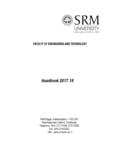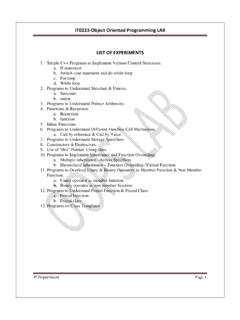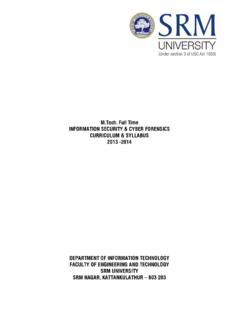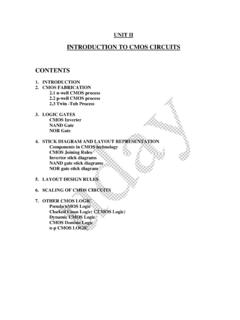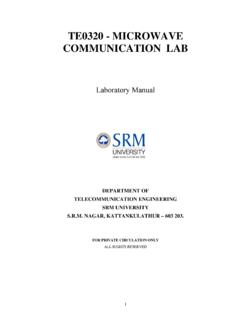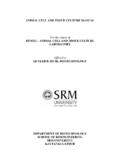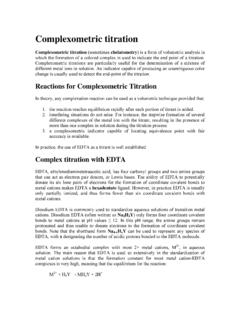Transcription of Experiment No.1 AMPLITUDE SHIFT KEYING
1 Experiment AMPLITUDE SHIFT KEYING Aim: To generate and demodulate AMPLITUDE SHIFT keyed (ASK) signal using MATLAB Theory Generation of ASK AMPLITUDE SHIFT KEYING - ASK - is a modulation process, which imparts to a sinusoid two or more discrete AMPLITUDE levels. These are related to the number of levels adopted by the digital message. For a binary message sequence there are two levels, one of which is typically zero. The data rate is a sub-multiple of the carrier frequency. Thus the modulated waveform consists of bursts of a sinusoid. One of the disadvantages of ASK, compared with FSK and PSK, for example, is that it has not got a constant envelope.
2 This makes its processing (eg, power amplification) more difficult, since linearity becomes an important factor. However, it does make for ease of demodulation with an envelope detector. Demodulation ASK signal has a well defined envelope. Thus it is amenable to demodulation by an envelope detector. Some sort of decision-making circuitry is necessary for detecting the message. The signal is recovered by using a correlator and decision making circuitry is used to recover the binary sequence. Algorithm Initialization commands ASK modulation 1. Generate carrier signal. 2. Start FOR loop 3.
3 Generate binary data, message signal(on-off form) 4. Generate ASK modulated signal. 5. Plot message signal and ASK modulated signal. 6. End FOR loop. 7. Plot the binary data and carrier. ASK demodulation 1. Start FOR loop 2. Perform correlation of ASK signal with carrier to get decision variable 3. Make decision to get demodulated binary data. If x>0, choose 1 else choose 0 4. Plot the demodulated binary data. 1 Program %ASK Modulation clc; clear all; close all; %GENERATE CARRIER SIGNAL Tb=1; fc=10; t=0:Tb/100:1; c=sqrt(2/Tb)*sin(2*pi*fc*t); %generate message signal N=8; m=rand(1,N); t1=0;t2=Tb for i=1:N t=[t1:.01:t2] if m(i)> m(i)=1; m_s=ones(1,length(t)); else m(i)=0; m_s=zeros(1,length(t)); end message(i,:)=m_s; %product of carrier and message ask_sig(i,:)=c.
4 *m_s; t1=t1+(Tb+.01); t2=t2+(Tb+.01); %plot the message and ASK signal subplot(5,1,2);axis([0 N -2 2]);plot(t,message(i,:),'r'); title('message signal');xlabel('t--->');ylabel('m(t)'); grid on hold on subplot(5,1,4);plot(t,ask_sig(i,:)); title('ASK signal');xlabel('t--->');ylabel('s(t)'); grid on hold on end hold off %Plot the carrier signal and input binary data subplot(5,1,3);plot(t,c); title('carrier signal');xlabel('t--->');ylabel('c(t)'); grid on subplot(5,1,1);stem(m); title('binary data bits');xlabel('n--->');ylabel('b(n)');gr id on 2 % ASK Demodulation t1=0;t2=Tb for i=1:N t=[t1:Tb/100:t2] %correlator x=sum(c.)
5 *ask_sig(i,:)); %decision device if x>0 demod(i)=1; else demod(i)=0; end t1=t1+(Tb+.01); t2=t2+(Tb+.01); end %plot demodulated binary data bits subplot(5,1,5);stem(demod); title('ASK demodulated signal'); xlabel('n--->');ylabel('b(n)');grid on 3 Model Graphs Result The program for ASK modulation and demodulation has been simulated in MATLAB and necessary graphs are plotted. 4 Experiment PHASE SHIFT KEYING Aim: To generate and demodulate phase SHIFT keyed (PSK) signal using MATLAB Generation of PSK signal PSK is a digital modulation scheme that conveys data by changing, or modulating, the phase of a reference signal (the carrier wave).
6 PSK uses a finite number of phases, each assigned a unique pattern of binary digits. Usually, each phase encodes an equal number of bits. Each pattern of bits forms the symbol that is represented by the particular phase. The demodulator, which is designed specifically for the symbol-set used by the modulator, determines the phase of the received signal and maps it back to the symbol it represents, thus recovering the original data. In a coherent binary PSK system, the pair of signal S1(t) and S2 (t) used to represent binary symbols 1 & 0 are defined by S1 (t) = 2Eb/ Tb Cos 2 fct S2 (t) = 2Eb/Tb (2 fct+ ) = - 2Eb/Tb Cos 2 fct where 0 t< Tb and Eb = Transmitted signed energy for bit The carrier frequency fc =n/Tb for some fixed integer n.
7 Antipodal Signal: The pair of sinusoidal waves that differ only in a relative phase SHIFT of 180 are called antipodal signals. BPSK Transmitter Binary Wave Product BPSK signal (Polar form) Product Modulator c1 (t) = 2/Tb cos 2 fct 5 The input binary symbols are represented in polar form with symbols 1 & 0 represented by constant AMPLITUDE levels Eb & - Eb. This binary wave is multiplied by a sinusoidal carrier in a product modulator. The result in a BSPK signal. BSPK Receiver: PSK signal x Choose 1 if x > 0 Choose 0 if x < 0 c1 (t).
8 X dt Decision device The received BPSK signal is applied to a correlator which is also supplied with a locally generated reference signal c1 (t). The correlated o/p is compared with a threshold of zero volts. If x> 0, the receiver decides in favour of symbol 1. If x< 0, it decides in favour of symbol 0. Algorithm Initialization commands PSK modulation 1. Generate carrier signal. 2. Start FOR loop 3. Generate binary data, message signal in polar form 4. Generate PSK modulated signal. 5. Plot message signal and PSK modulated signal. 6. End FOR loop. 7. Plot the binary data and carrier. PSK demodulation 1.
9 Start FOR loop Perform correlation of PSK signal with carrier to get decision variable 2. Make decision to get demodulated binary data. If x>0, choose 1 else choose 0 3. Plot the demodulated binary data. 6 Program % PSK modulation clc; clear all; close all; %GENERATE CARRIER SIGNAL Tb=1; t=0:Tb/100:Tb; fc=2; c=sqrt(2/Tb)*sin(2*pi*fc*t); %generate message signal N=8; m=rand(1,N); t1=0;t2=Tb for i=1:N t=[t1:.01:t2] if m(i)> m(i)=1; m_s=ones(1,length(t)); else m(i)=0; m_s=-1*ones(1,length(t)); end message(i,:)=m_s; %product of carrier and message signal bpsk_sig(i,:)=c.
10 *m_s; %Plot the message and BPSK modulated signal subplot(5,1,2);axis([0 N -2 2]);plot(t,message(i,:),'r'); title('message signal(POLAR form)');xlabel('t--->');ylabel('m(t)'); grid on; hold on; subplot(5,1,4);plot(t,bpsk_sig(i,:)); title('BPSK signal');xlabel('t--->');ylabel('s(t)'); grid on; hold on; t1=t1+ ; t2=t2+ ; end hold off %plot the input binary data and carrier signal subplot(5,1,1);stem(m); title('binary data bits');xlabel('n--->');ylabel('b(n)'); grid on; subplot(5,1,3);plot(t,c); title('carrier signal');xlabel('t--->');ylabel('c(t)'); grid on; 7 % PSK Demodulation t1=0;t2=Tb for i=1:N t=[t1.]
